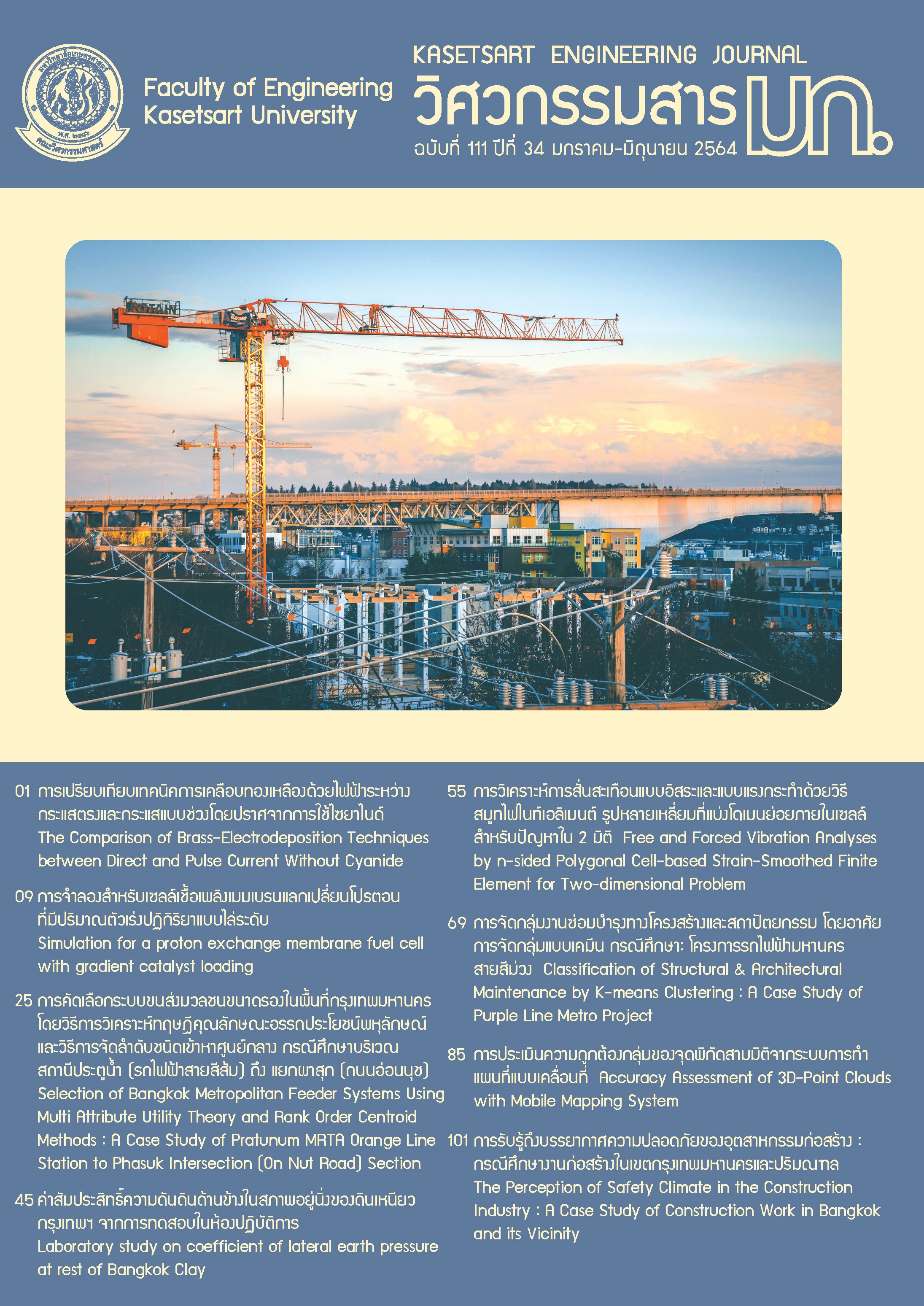Laboratory study on coefficient of lateral earth pressure at rest of Bangkok Clay
Keywords:
coefficient of earth pressure at rest, consolidation, Bangkok Clay, triaxial testAbstract
This research investigates a coefficient of earth pressure at rest of Bangkok Clay from a one-dimensional consolidation test in a laboratory. The consolidation test is performed by a triaxial apparatus by which a constant rate of axial strain is applied and horizontal stress is continuously adjusted to achieve a condition of volumetric strain equals to axial strain. The triaxial apparatus has been developed to be able to monitor axial and volumetric strains and automatically adjust horizontal stress. The obtained consolidation properties by this method are compared with those obtained from the conventional oedometer test. The obtained Ko properties are analyzed and compared with available empirical equations and published experimental data. The potential errors of the test results are discussed.
References
Franzius J N, Potts D M, and Burland J B (2005). The influence of soil anisotropy and Ko on ground surface movements resulting from tunnel excavation. Geotechnique, 55(3): 189-199.
Lambe T W, and Whitman R V (1969). Soil Mechanics. John Wiley & Sons.
Poulos H G, and Davis E H (1972). Laboratory determination of in-situ horizontal stress in soil masses. Geotechnique, 22: 177-182.
Folkes D J, and Crooks J H A (1985). Effective stress paths and yielding in soft clays below embankments. Canadian Geotechnical Journal, 22(3): 357-374.
Graham J, and Lau S L K (1988). Stress release, undrained storage, and reconsolidation in simulated underwater clay. Canadian Geotechnical Journal, 24: 275-288.
Jamiolkowski M, Leroueil S, and Lo Presti D C F (1991). Design parameters, from theory to practice. Geo-coast 91, 2: 877-917.
Jaky J (1948). Pressure in silo. Proc. 2nd Int. Conf. on Soil Mechanics and Foundation Engineering, Rotterdam, 1: 103.
Brooker E W, and Ireland H O (1965). Earth pressure at rest related to stress history. Canadian Geotechnical Journal, 2(1): 1-15.
Alpan I (1967). The empirical evaluation of the coefficient Ko and Kor. Soils and Foundations, 7(1): 31-40.
Bolton M D (1991). Geotechnical stress analysis for bridge and abutment design. Contractor Report 270, Crowthorne, Transport and Road Research Laboratory.
Simpson B (1992). Retaining structures: displacement and design. Geotechnique, 42(4): 541-576.
Schmidt B (1966). Discussion paper – Earth pressure at rest related to stress history. Canadian Geotechnical Journal, 3(4): 239-242.
Mayne P W, and Kulhawy F H (1982). Ko – OCR Relationships in Soils. Journal of the Geotechnical Engineering Division, ASCE, 108(GT6): 851-872.
Krogsbol A, Hededal O, and Foged N (2012). Determination properties of highly plastic fissured Plalaeogene clay – Lack of stress memory?. Proc. NGM 2012, Nordisk Geoteknikermode 1/2, pp. 133-140.
Lefebvre G, Bozozuk M, Philibert A, and Hornych P (1991). Evaluating Ko in Champlain clays with hydraulic fracture tests. Canadian Geotechnical Journal, 28(3): 365-377.
Hamouche K K, Leroueil S, Roy M, and Lutenegger A J (1995). In situ evaluation of Ko in eastern Canada clays. Canadian Geotechnical Journal, 32: 677-688.
Wroth C P (1973). General theories of earth pressure and deformation. Proc. 5th European Conference on Soil Mechanics and Foundation Engineering, 2: 33-52.
Bergado D T, Long P V, and Muthy B R S (2002). A case study of geotextile-reinforced embankment on soft ground. Geotextiles and Geomembranes, 20: 343-365.
Ladd C C (1991). Stability evaluation during staged construction. Journal of Geotechnical Engineering, ASCE, 117(4): 537-615.
Som N N (1970). Lateral stresses during one-dimensional consolidation of an over-consolidated clay. Proc. 2nd Southeast Asian Conf. on Soil Engineering, pp. 259-307.
Tavenas F A, Blanchette G, Leroueil S, Roy M, and La Rochelle F (1975). Difficulties in the in-situ determination of Ko in soft sensitive clays. Proc. ASCE Special Conf. on In-situ Measurement of Soil Properties, 1: 450-476.
Becker D E, Crooks J H A, Been K, and Jefferies M G (1987). Work as a criterion for determining in situ and yield stresses in clays. Canadian Geotechnical Journal, 24(4): 549-564.
Bishop A W (1958). Test requirements for measuring the coefficient of earth pressure at rest. Proc. Brussels Conf. on Earth Pressure Problems, 1: 2-14.
Burland J B, and Maswoswe J (1982). Discussion on In situ measurements of horizontal stress in overconsolidated clay using push-in spade-shaped pressure cells. Geotechnique, 32(2): 285-286.
Chang M F (1973). A rational method for determining the in-situ coefficient of earth pressure at rest. M.Eng thesis, AIT.
Wang W T (1975). Ko determination by hydraulic fracturing. M.Eng. thesis, AIT.
Shibuya S, Tamrakar S B, and Theramast N (2001). Geotechnical site characterization on engineering properties of Bangkok Clay. Geotechnical Engineering, SEAGS, 32(3): 139-151.
Prust R E, Davies J, and Hu S (2005). Pressuremeter Investigation for Mass Rapid Transit in Bangkok, Thailand. Transportation Research Record: Journal of the Transportation Research Board, 1928: 207-217.
Lai K C (1993). Comparison of Recompression and SHANSEP strength-deformation properties of undisturbed Bangkok clay. M.Eng. thesis, AIT.
Downloads
Published
Issue
Section
License

This work is licensed under a Creative Commons Attribution-NonCommercial-NoDerivatives 4.0 International License.


